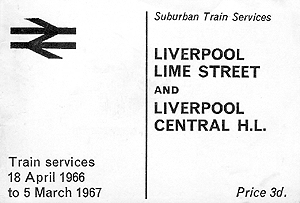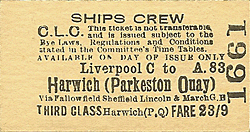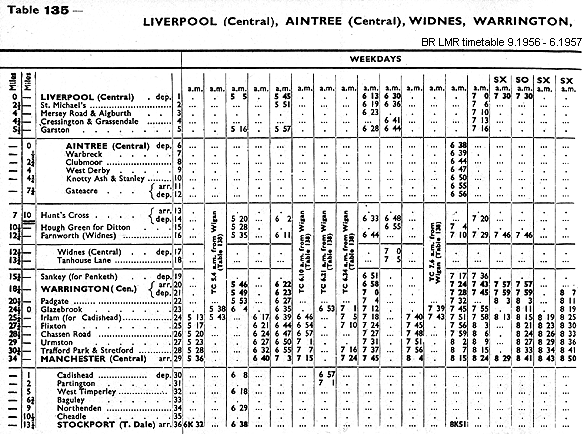
LIVERPOOL CENTRAL HIGH LEVELTRAIN SERVICES
|
In the early years there were sixteen trains per day to Manchester London Road. On 9 July 1877 the CLC opened a temporary Manchester Central station and from that date the Manchester services used it. An hourly express service was introduced on the same day that completed the journey in just over 45 minutes. The temporary Manchester Central was replaced with a permanent facility on 1 July 1880. Other services ran to Stockport and to destinations further afield (including London) on the networks of the owning companies. On 1st December 1879 a train service to Walton-on-the-Hill in north Liverpool was introduced via Hunts Cross and the new North Liverpool Extension Line, east of the city. On 13 July 1880 it was extended to Huskisson, only to be cut back to Walton-on-the-Hill again on 1 May 1885. On 1 September 1884 a service to Southport Lord Street was introduced which also ran via the North Liverpool Extension Line, then over the Southport & Cheshire Lines Extension Railway.
During the 1880s the CLC offered the fastest journey times between Liverpool and Manchester, at 45 minutes for a 34 mile journey. In 1883 this was reduced to 40 minutes for some services which used a Warrington avoiding line. Although compared to the other major terminus stations in Liverpool (the LNWR at Lime Street and the L&YR at Exchange) Central had fewer feeder lines and therefore handled less traffic, services increased to 85 departures on weekdays. On 1st July 1897 the MS&LR changed its name to the Great Central Railway (GCR) and on 15th March 1899 it opened a main line to London Marylebone. By 1907 each of the CLC partners served London. The GCR ran trains to London Marylebone, the GNR to London Kings Cross and the MR to London St Pancras. The GNR service took over six hours, so it was hardly competitive with the LNWR services from Lime Street, and offered only one service per day. GCR services – one outbound and two returns - took a similar length of time. MR trains took four hours and twenty minutes which was still slower than the LNWR, but their trains were luxurious and so proved popular with passengers.
After the grouping in 1923 the CLC Manchester expresses continued to run and to be highly competitive with the services out of Liverpool Lime Street which was now part of the LMS, as was Liverpool Exchange which also ran Manchester express services. Services still ran to both London Marylebone (LNER) and London St Pancras (LMS). The LMS tended to concentrate its London services on its route from Liverpool Lime Street although by summer 1932 they still provided four weekday services to St Pancras. They also ran trains to both Cheadle Heath and Chinley from where connections with southbound mainline services could be made using the former MR route. Direct LMS services also operated to Buxton.
During the 1930s the CLC had services to Gateacre, Stockport Tiviot Dale, Southport Lord Street, Warrington Central, Widnes Central and, of course, to Manchester Central. The LNER ran a number of services to the east coast, in particular to Hull. They also provided trains to Harwich for onward connections to Holland. World War II saw a reduction in services at Liverpool Central but in May 1941 Liverpool suffered its worst air raids. The former L&Y line into Liverpool Exchange was badly damaged preventing trains from reaching the terminus. To help move the many commuters who travelled between Southport and the city on the line out of Exchange the CLC laid on extra trains between Liverpool Central and Southport Lord Street. Once the approaches to Exchange were able to cater for a full service again the CLC service reverted to its infrequent pattern.
The September 1956 - June 1957 timetable listed 37 weekday departures from the main line platforms: the first was at 5.05 am to Stockport Tiviot Dale. The last departure was at 10.10 pm, also to Stockport Tiviot Dale, but via Manchester Central. There were regular services throughout the day to Manchester Central and to Warrington. Other services ran to Gateacre, Hull, Nottingham Midland, Tanhouse Lane (Widnes) and Harwich. At 9.30 pm a train left for London Marylebone.
In 1959 and 1960 DMUs were introduced on many services from the main line platforms. For the Manchester Central service the four-coach DMUs had doors at all seats so passengers board or alight briskly at stations. Some services were improved with the introduction of the DMUs. In 1960 daily departures from Liverpool Central were listed to Aintree Central, Gateacre, Harwich Parkeston Quay, Hull, Hunts Cross, Leicester Central, London Marylebone, Manchester Central, Nottingham Victoria, Stockport Tiviot Dale, Tanhouse Lane, and Warrington Central. All services north of Gateacre to Aintree Central were withdrawn on 7 November 1960. By this time, though, an hourly DMU service between Liverpool Central and Gateacre had become the norm.
To return to main page click here |

|
| Last updated: Sunday, 21-May-2017 14:31:43 CEST | © 1998-2014 Disused Stations |

 Other regular services in the first decade of the 20th Century included the CLC Manchester expresses, CLC local services to Warrington, Walton-on-the-Hill and to Stockport, MR semi-fast services to Sheffield via Chinley, GCR services to Norwich, Lowestoft and Harwich, and GNR services to and from the east coast.
Other regular services in the first decade of the 20th Century included the CLC Manchester expresses, CLC local services to Warrington, Walton-on-the-Hill and to Stockport, MR semi-fast services to Sheffield via Chinley, GCR services to Norwich, Lowestoft and Harwich, and GNR services to and from the east coast. 

 From the low level platforms there were 260 departures on weekdays, with trains every few minutes from 6.00 am until 11.33 pm. The significance of the low level platforms is clearly demonstrated by the intensive service.
From the low level platforms there were 260 departures on weekdays, with trains every few minutes from 6.00 am until 11.33 pm. The significance of the low level platforms is clearly demonstrated by the intensive service. 
 Home Page
Home Page